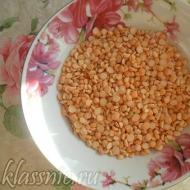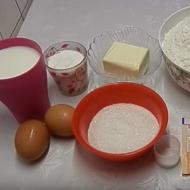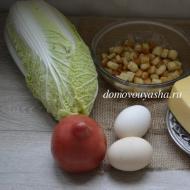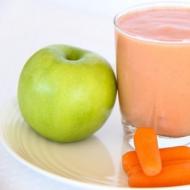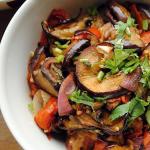
How much do I taste in a melon? Composition and beneficial properties of melon. Ingredients: calories, vitamins and microelements
Melon is a sweet and visually attractive fruit with a special taste. A representative of hot Africa and Asia, it has many vitamins and microelements. If we talk about the calorie content of melon, its natural sugars are easily absorbed by the body.
The most popular varieties of sweet melon on Russian shelves are Kolkhoznitsa and Torpeda. The ripe exotic fruit is very sweet and is usually eaten fresh. Many women, worried about their slimness, are afraid of acquiring extra deposits on the waist and sides, content with the unique taste of the sweet fruit. The calorie content of melon worries them most.
Useful properties of melon
Since melon can only be enjoyed on hot summer days, you need to take a lot of vitamins for the whole year. Despite the small calories, melon is a real “first aid kit”.
The exotic product contains a large amount of ascorbic acid. Vitamin C will help you defeat viral colds and significantly improve your immunity. The relatively low calorie content of melon is inferior to its vitamin composition and usefulness.
Due to the large amount of fiber, the introduction of melon into the daily diet helps improve intestinal function, removes bad cholesterol from the body, and melon calories are insignificant. This product is recommended for patients after surgery to restore blood volume. Diseases of the nervous system are also successfully treated with the natural substances of this fruit.
Contraindications to the use of sweet melon
You should know that not everyone can eat melon. The product should not be used by diabetics or those with peptic ulcers. It should be noted that melon calories do not play a significant role, while melon is incompatible with some products (dairy) and causes allergic reactions and digestive disorders.
Exotic fruits are prohibited in the diet of nursing mothers, since the infant suffers from colic from this. Also, people with diabetes should not consume this food product due to the calorie content of melon.
Those who prefer to enjoy the juicy fruit should know that melon should be eaten between main meals, otherwise intestinal problems may occur.
How many calories are in sweet melon?
So, for those losing weight, it is important to know the exact calorie content of melon. This is 36 kilocalories per 100 grams of product. You can judge a decent amount of sugar in a product by tasting its juicy pulp. Melon is eaten raw, with the skin removed. In order to get pleasure and taste sensations, you need to choose the right melon at the point of sale. If it is ripe, there are guarantees to receive valuable nutrients and a maximum of vitamins, for example, Torpedo melon, the caloric content of which does not pose a danger to those losing weight.
And one more important condition of any diet: if you lead an active lifestyle, you should not think about how many calories are in a melon. Physical activity will remove excess calories and fat deposits. Therefore, be healthy and consume more vitamins in your diet.
When counting melon calories, many people who are losing weight make a big mistake by excluding the overseas fruit from their diet. A sweet, ripe melon contains 17 times more iron than the same amount of milk. The product is also rich in calcium, magnesium, vitamins B1, B2, A. The fruit is used in nutrition for the prevention and treatment of atherosclerosis and cardiovascular diseases.
Despite the presented calorie content, melon has a strong diuretic effect. Therefore, mono-diets based on the consumption of exotic fruit are somewhat dangerous for those people who have problems with the gastrointestinal tract and blood vessels. But even completely healthy people do not need to indulge in a melon diet for more than three days, since the latter perfectly cleanses the body of accumulated toxins and waste.
Melon Torpedo: calorie content and the desire to lose weight
 If you had to choose a melon at the market, then you probably noticed that the varieties of melons differ significantly from each other in shape (round and oval), weight (from 1 kg to 16 kg), color (they are yellow, green, striped, brown). But the nutritional value comes from the juicy and tasty pulp of the center of the fruit, and the seeds of the fruit also have beneficial value. By eating sweet melon daily, you nourish your body with many vitamins and improve immunity, so here it would probably be inappropriate to count how many calories a melon contains.
If you had to choose a melon at the market, then you probably noticed that the varieties of melons differ significantly from each other in shape (round and oval), weight (from 1 kg to 16 kg), color (they are yellow, green, striped, brown). But the nutritional value comes from the juicy and tasty pulp of the center of the fruit, and the seeds of the fruit also have beneficial value. By eating sweet melon daily, you nourish your body with many vitamins and improve immunity, so here it would probably be inappropriate to count how many calories a melon contains.
The Torpedo variety is the sweetest, so the calorie content of Torpedo melon is about 36 kilocalories per 100 grams of product. If we compare the energy value of 15-ounce kefir with the calorie content of this variety, then kefir is much higher in calories. Due to its low calorie content, Torpedo melon is rightfully classified as a dietary, low-calorie product. This variety can be safely consumed by those who closely monitor the slimness of their figure.
Melon Kolkhoznitsa: calorie content and a storehouse of vitamins
Which type of melon to choose? If your main goal is the desire to lose weight, then it is better to opt for a low-calorie variety. Thus, the calorie content of Kolkhoznitsa melon is 31 kilocalories per 100 grams of product. Even by taste, you can determine that this variety is low-calorie, since the pulp is not cloyingly sweet, but has a more delicate and light taste. This variety of melon contains much less saccharides, so nutritionists recommend consuming the Kolkhoznitsa melon variety in your diet, whose calorie content is lower than the Torpedo variety.
Melon is usually consumed fresh, but it retains its freshness and attractiveness only in the summer. Therefore, in order to saturate the body with useful substances, it is enough not only to consume the fruit in large quantities in the summer, but you can dry it. The calorie content of dried melon is much higher in fresh form - 344 kilocalories per 100 grams. The figure is impressive, but the fruit itself is a little sugary in taste, so you won’t be able to eat a lot. Therefore, for those losing weight, there is no need to get carried away with dried melon; it is much more effective to replace it with fresh, low-calorie one.
If you want to have a fasting melon day, you can afford it. The calorie content of melon should not worry you; the juicy beauty will free the body of toxins and accumulated toxic substances. A mono-diet for one day will perfectly cleanse your body and take care of your health. To this end, take our advice: eat Kolkhoznitsa melon, the calorie content of which will put your body in order.
The tropical juicy fruit has long been used as a medicinal product for weight loss. After all, melon calories are insignificant for the body; only its nutritional value is of great importance. Its diuretic and laxative effect best promotes the removal of not only toxins, but also excess fluid accumulating in the body. Special enzymes in the chemical composition of the product also help rid the body of excess weight, thereby promoting weight loss.
4.1 out of 5 (9 Votes)
How to eat melon, can you eat it at night, how many calories are in melon, what vitamins are in it, what are its benefits and harms. Probably no other berry causes as much controversy as it does. And yet, despite this, it is popular with most people, especially chilled, especially in the heat.
But we promised to talk about the benefits and harms of melon.
How many calories are in melon
The calorie content of melon depends on its variety, those that are sweeter are higher in calories, and regular white melon is the lowest in calories. But on average, 100 g of melon contains 33 calories.
Nutritional value of melon (100 g): proteins - 0.6 g, fats - 0.3 g, carbohydrates - 7.4 g.
As you can see, even those who are on a diet can eat melon. Primarily because the fruits are low-calorie. In addition, it does not contain much sugar, mainly fiber, a huge amount of minerals, vitamins and other useful substances.
Melon pulp is quite filling and helps cope with hunger for a long time. But! Regarding whether it is possible to eat it at night. The product copes well with insomnia and even improves well-being. But for the pancreas, melon will be a strong load, or rather an excessive amount of it. Therefore, follow the norm, do not overeat and try not to eat it 3 hours before bedtime so that it is absorbed by the body.
Benefits of melon
To begin with: melon is useful for losing weight, because it contains a lot of fiber, which has a great effect on the microflora of the stomach and the gastrointestinal tract, and eliminates “bad” cholesterol. It speeds up metabolism and gives you a feeling of fullness for a long time.
Melon is also useful because it contains many vitamins, including: vitamins A, B1, B2, B5, B6, B9, C, E, H and PP. In addition, the pulp of the fruit contains many minerals (potassium, magnesium, zinc, calcium, iron, copper and manganese, chlorine and iodine, sulfur, fluorine, phosphorus and sodium. This all makes it a superfood for the skin. Thanks to the presence of antioxidants, this berry can improve condition of the skin and mucous membranes. They also slow down the aging process. So, girls, take note: melon helps get rid of acne and protects against premature aging.
Eating melon is also beneficial for strengthening the immune system and preventing colds. The fruits are indicated for kidney diseases and urolithiasis, as they have mild diuretic properties (another bonus for those who want to lose weight).
Melon also has anti-stress properties; its pulp actively fights insomnia and anxiety, and improves mood.
Melon contains a large amount of folic acid, which is beneficial for hematopoiesis. Folic acid also lowers the level of "bad" cholesterol.
Every year at the end of August, having absorbed all the warmth of the hot summer, juicy and aromatic fruit appears on the shelves of markets and shops. This amazing berry weighing from 300 g to 20 kg, originally from South-West Asia, when fresh is the best dessert created by nature itself. But melon is not only consumed fresh, it is dried, salted, and made into compotes, jam, candied fruits and marmalade. As a side dish, in the Middle East it is often served with fish, and in Italy with meat. This berry is fried in batter and even honey is made from it.
Melon is loved almost all over the world. In some countries there are even holidays in her honor. For example, in France, from July 10 to 14, a festival is held in honor of Her Majesty Melon. And in Turkmenistan, the second Sunday of August is a national holiday - Melon Day.
Melon has a delicate taste and delicate aroma. In addition, it contains:
- quite a lot of vitamin C - about 20 mg per 100 g of product (about 30% of the daily requirement);
- folic acid;
- iron;
- silicon;
- B vitamins;
- beta carotene.
At the same time, melon has relatively few calories - only 30-35 kilocalories per 100 g.
Melon - proteins, fats, carbohydrates
The composition of melon largely depends on the variety and conditions in which it was grown. On average, 100 g of product contains:
- proteins - 0.6 g;
- fats – 0.3 g;
- carbohydrates – 7.5 g;
- water – 88.5 g;
- the remaining 3.1 g comes from pectins, fiber, vitamins, minerals and organic acids.
As can be seen from the above data, the basis of melon is water and carbohydrates, most of which are easily digestible sugars - glucose and fructose. By the way, the sugar content in a melon is also greatly influenced by the properties of the soil on which this crop is grown: if a melon grew on chernozem soil, then it contains one and a half to two times more sugar than, for example, on chestnut and sandy loam soils. Since melon contains a lot of “fast” carbohydrates (glucose, fructose),  this dessert has a fairly high glycemic index (a parameter showing how quickly a given product raises blood sugar levels) - about 50. For comparison, pasta is 40. In addition, 100 g of product (1 piece) is equal to 1 bread unit. Therefore, people suffering from diabetes, as well as those who want to lose weight, should consume melon with great caution. Also, melon should not be consumed by people with infectious diseases of the gastrointestinal tract, people suffering from gastritis and peptic ulcers in the acute stage, as well as nursing mothers if their baby is less than 3 months old.
this dessert has a fairly high glycemic index (a parameter showing how quickly a given product raises blood sugar levels) - about 50. For comparison, pasta is 40. In addition, 100 g of product (1 piece) is equal to 1 bread unit. Therefore, people suffering from diabetes, as well as those who want to lose weight, should consume melon with great caution. Also, melon should not be consumed by people with infectious diseases of the gastrointestinal tract, people suffering from gastritis and peptic ulcers in the acute stage, as well as nursing mothers if their baby is less than 3 months old.
For those who adhere to a strict diet and count calories, this is undoubtedly an important aspect. And considering the fact that the residents of our country have a very short period of time to be satisfied with its taste - and even more so.
Queen melon
The benefits and harms, calorie content and secrets of consuming this tasty product are described below.
Have you ever wondered why this wonderful berry is an honorary comrade in the slimmer ranks? It has excellent dietary qualities and beneficial properties, which not every product can boast of.
The calorie content of 100 grams of fresh melon is only 30-39 kcal, depending on the variety. And based on the fact that the average fruit weighs about 1300 grams, then in total it does not exceed 455 kilocalories, which is an extremely small figure even for those people who are at the stage of maintaining an ideal weight and consume a daily intake of 1200-1500 kilocalories . In addition, it contains many useful vitamins and microelements, and at the same time it has a minimal starch content, the excess of which does not have the best effect on the process of weight loss.
Melon, whose calorie content in a diet does not make one doubt its unsurpassed dietary properties, is still not compatible with all foods. And all because combined use with them can cause fermentation due to the increased sugar content and, as a result, provoke weight gain.
Eating this product and losing weight is not a sky-high dream, but a real reality. However, you should not stick to such a diet for a long time, if only for the reason mentioned above. These are, rather, fasting days, during which it is easy to endure food restrictions and not go astray from the intended path.
Melon, whose calorie content per 100 grams is very low, serves not only as a low-calorie delicacy, but is also a storehouse of vitamins, which include PP, E, B 9 (folic acid), B 6 (pyridoxine), B 5 (pantothenic acid), B 2 (riboflavin), B 1 (thiamine), A and beta-carotene.
These, in turn, are directly related to cobalt (Co), fluorine (F), manganese (Mn), copper (Cu), iodine (I), zinc (Zn), iron (Fe), sulfur (S), chlorine (Cl), phosphorus (P), potassium (K), sodium (Na), magnesium (Mg) and calcium (Ca).
Melon, whose calorie content per 100 grams allows you to consume the product in unlimited quantities and not worry about the condition of your figure, is a real godsend for those with a slimmer sweet tooth.

It is an irreplaceable source of iron, its content being 17 times higher than the amount in milk.
Melon: calories, benefits and harm
Regular use of it is a way not only to prevent the risk of developing liver and kidney diseases, but also to overcome the symptoms of high blood pressure, rheumatism and some heart disorders. And thanks to the high silicon content, melon supplies the body with building substances necessary for the growth of hair, nails and restoration (renewal) of the skin.
Melon, whose calorie content per 100 grams is extremely low, is an excellent source of serotonin, which contributes to the production of joy hormones and maintaining an excellent mood.
At the same time, its pulp can be extremely harmful for people who suffer from such ailments as peptic ulcers, diabetes mellitus and various types of infectious diseases of the gastrointestinal tract. It is completely contraindicated for nursing mothers - as doctors say.
Such a different melon
Calorie content per 100 grams of product may vary slightly depending on the variety in front of us. Its most common types include Altai, Pineapple, Golden, Transnistrian melons, as well as varieties such as Aikido, Assol, Basarabia, Blondie, Galileo, Cinderella, Iroquois, Millennium, Augen and Sweet pineapple.

It is customary to distinguish between sun-dried and dried melon, but in essence they are the same thing.

Both the first and second are obtained as a result of natural heat treatment. In other words, they cook in the sun.
Dried melon, whose calorie content varies around 340 kilocalories, is in no way inferior in content and number of beneficial properties to the fresh fruit. Therefore, if you want to enjoy something tasty and at the same time not harm your figure, you should choose fresh berries.
And you can diversify yours with a simple summer soup recipe.
Melon soup
To prepare it you will need:
1 melon weighing about 2 kg ≈ 700 kcal;
2 cucumbers ≈ 30 kcal;
1 tbsp. lemon juice ≈ 88 kcal;
200 grams of natural yogurt ≈ 107 kcal;
50 grams of arugula ≈ 10 kcal;
1 red chili pepper;
Salt, mint and pepper to taste.
Preparation:
- Rinse the melon.
- Cut into small squares.
- Remove the peel from the cucumbers.
- Cut into slices.
- Blend the cucumbers and melon in a blender until smooth.
- Then add the remaining products from the list and beat again.
- Place the soup in the refrigerator for half an hour and after the time has passed, serve it, garnished with mint leaves and crushed ice (or without it).
This version of the soup will be enjoyed on a hot summer day and will save you from the inevitable heat. Moreover, it will not leave a trace in the form of extra centimeters due to its low calorie content.

And remember that dried melon, whose calorie content is incomparably high compared to a fresh product, is a good independent product. But it is better to use it in small doses.
- was raised by Styrian Christopher Schieder in Austria at the end of 2009. Its weight was approximately half a ton - 500 kilograms.
- For the first time, melon is mentioned in Biblical legends.
- Eating melon promotes an even and beautiful tan.
Many representatives of the fair sex exclude melon from their diet, believing that consuming such a sweet and juicy fruit will definitely negatively affect their figure. But this opinion is very erroneous, because... Having learned how many calories this fruit contains and how it affects the body, any woman will definitely include it in her diet.
How many calories does a melon have?

The statement that sweet melon has a lot of calories is false. On average, a small piece of fruit (100 grams) contains only 30 to 35 calories, which makes it a very valuable dietary product. This low calorie content is explained by the high water content in the fruit (about 60-70%), which allows you to get enough of the fruit very quickly without worrying about your figure.
But the dietary properties of melon are influenced not only by its low calorie content, but by the composition of the fruit itself, which, in addition to vitamins and minerals, also includes a significant amount of useful substances that help burn calories.
A number of diets are based exclusively on the consumption of melon, because... it has the following properties:
- Contains enzymes that break down fat and burn excess calories.
- It has a slight laxative and diuretic effect, which allows you to remove excess fluid from the body and get rid of toxins.
- Contains a significant amount of fiber, which improves digestion and binds fats.
Mono-diets based on melon allow you to remove extra centimeters, thanks to the rapid cleansing of accumulated harmful substances and toxins. Although you should not indulge in such mono-diets for more than three days - due to the diuretic effect of the fruit.
The calorie content of melon consumed as food is also affected by the foods with which this fruit is consumed. You should also not eat the fruit as part of various desserts - candied fruits, jam and other sweets made from melon are very high in calories. It is advisable not to combine any foods or drinks with the fruit, and eat the fruit separately - in between main meals.
The calorie content of melon largely depends on the form in which the fruit is consumed - raw or dried. Dried fruits are several times superior in energy value to raw fruits - they contain 345 kcal (per 100 grams).
Nutritional and energy value of melon
How many calories are in raw fruits depends on the type of fruit; the most common on the market are melons of the Torpedo and Kolkhoznitsa types.
Calories of melon varieties

The Kolkhoznitsa variety is considered the lowest-calorie type of melon. This can be determined even by taste - the pulp of the fruit of this variety is not cloyingly sweet, as in the Torpedo variety, but lighter and waterier in taste.
Considering how many calories there are in this form (31 kcal per 100 grams of product), and also the fact that the Kolkhoznitsa variety does not contain many saccharides, nutritionists recommend including this variety in their diet for those who want to lose weight.
In just one fasting day of the mono-diet on the Kolkhoznitsa melon, you can get rid of extra centimeters on the hips and waist by removing excess fluid and toxins from the body. At the same time, the calorie content of the fruit itself is insignificant for the body; what is more important is the nutritional value.
The Torpedo variety is distinguished by its large size and somewhat “elongated” oblong shape. This variety is the most sugary, aromatic and sweet of all types, because. contains more natural sugars.
If we count how many calories 100 grams of the Torpedo variety contains, then the energy indicator will be 35 kcal. This is much more than in other varieties of melon, but less than in the same one percent kefir, often used in diets. Therefore, Torpedo melon can also be classified as a light dietary product.
Other varieties of melon are approximately equal in calorie content: Charentais - 32 kcal, Honey - 33 kcal, etc.
The calorie content of any type of melon also depends on the degree of ripening of the fruit - the juicier and sweeter the fruit, the greater its energy value. But this does not mean that you should include unripe or unsweetened fruits in your diet.
In order for melon to bring maximum benefits, it should be eaten only during the ripening season - in summer. Otherwise, the fruit will not bring the expected result for weight loss, but, on the contrary, can harm your health - cause fermentation and indigestion.
The rich composition of useful components, combined with a fairly low energy value, makes melon a participant in many popular diets, because Rarely can a fruit be so sweet and so low in calories at the same time.


